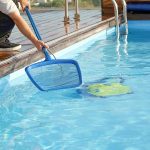Professional Pool Cleaning Tips – Lowering Alkalinity
Understanding water chemistry and how to balance a swimming pool is an essential part of being a pool owner or operator. There are so many different techniques and chemicals to learn. Here we would like to focus on one specific, yet important part of balancing pool water – lowering alkalinity. But what is alkalinity? Why is having high alkalinity levels bad and how do you lower them? Even if you use a professional pool cleaning service, this is good information to get a grasp on.
What Is Alkalinity?
Alkalinity describes the total concentration of dissolved carbonates, bicarbonates, hydroxides, and cyanurates present in the water. Alkalinity has a direct correlation with pH balance. Water with a high pH level typically correlates to high alkalinity levels and vice versa. Alkalinity is measured in parts per million or ppm. The correct amount of alkalinity in a swimming pool is between 80 and 120 ppm. High levels of alkalinity can occur after shocking the pool with chlorine since the chlorine shock is very alkaline. They can also occur from sunscreen, lotion, and body oils entering the pool or by refilling the pool with highly alkaline water. Many people rely on professional pool cleaning to correct the issue.
Why High Alkalinity Is An Issue
So you have high levels of alkalinity in your pool – what’s the big deal? Well first, this will irritate swimmers’ eyes and skin and nobody wants that. It also decreases how effective chlorine is at sanitizing the pool. This requires you to balance your water chemistry more often in order to maintain a sanitary swimming pool. Higher alkalinity also causes the pool water to become cloudy. As previously mentioned, high alkalinity correlates with high pH levels, which will need to be brought down for safe swimming. Finally, calcium deposits can build up on the surface of the pool and also within your pool equipment which can cause major damage. If you are untrained in pool operation and are experiencing high alkalinity levels, it’s a good idea to call someone for professional pool cleaning.
Lowering Alkalinity
There are multiple ways of lowering alkalinity in your swimming pool. One method is through the use of hydrochloric or muriatic acid. This acid measures between 1 and 2 on the pH scale and is a powerful method to remove rust, kill mold, and clear up calcium deposits. However hydrochloric acid can be very dangerous, as it is a volatile chemical. It may be best to hire a professional pool cleaning company to take care of the job. If you go DIY – make sure to protect yourself with a proper PPE chemical mask, goggles, rubber gloves, and long sleeves, follow the manufacturer’s directions, and read the SDS sheet.
Another method of reducing alkalinity is by using dry acid. Dry acid or sodium bisulfate has similar effects as hydrochloric acid but in a granular form that is safer to handle. This option is more expensive than hydrochloric acid and must be stored properly in a dry area.
Professional Pool Cleaning Experts
Lowering alkalinity is only one small part of understanding swimming pool water chemistry. You can learn more about this topic and much more by becoming a Certified Pool Operator (CPO®). The CPO® certification class is a great start to becoming a pool expert. Pool Operation Management’s award-winning CPO certification courses train you how to properly operate a swimming pool. Our two-day courses offer a wealth of information and training in everything from pool chemicals, to energy conservation to surface water removal. If you have no interest in learning, we can take care of the pool! For the very best in everything related to pools, contact us today.








